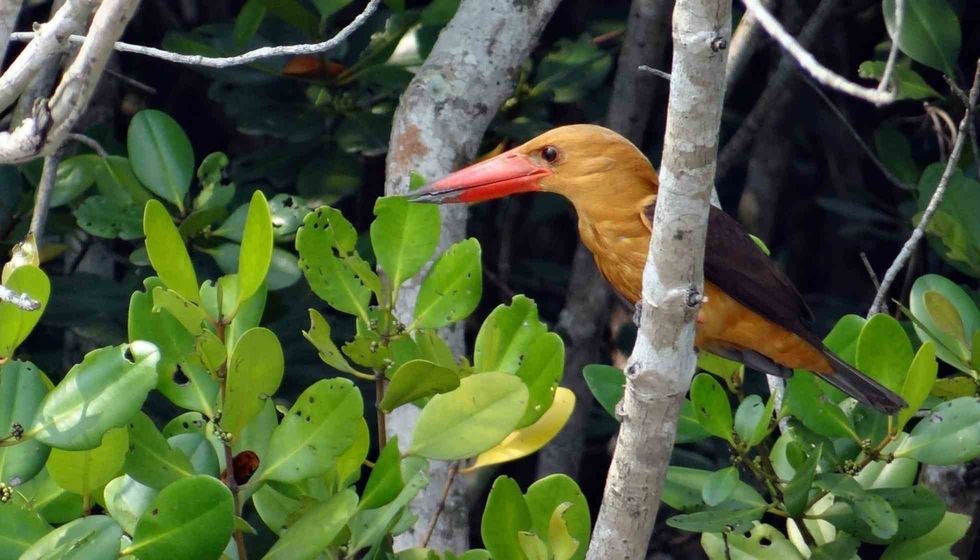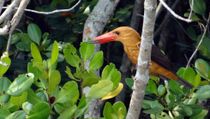The brown-winged kingfisher (Pelargopsis amauroptera) species of bird belongs to the Alcedinidae family and the order Coraciiformes. It is a type of tree kingfisher, which has been distributed across Asia. These birds are monotypic species of bird.
It is also known as the brown-winged stork-billed kingfisher because it is closely related to the stork-billed kingfisher and the great billed kingfisher. Brown-winged kingfishers (Pelargopsis amauroptera) are native to India, Thailand, Myanmar, Malaysia, and Bangladesh. Their conservation status is Near Threatened as their population has been decreasing.
The brown-winged kingfisher (Pelargopsis amauroptera) makes a harsh, cackling 'chack chack' sound. In India, they are found in the states of West Bengal and Odisha, including Ayeyarwady Delta and the Sundarbans as their major habitats.
Their clutch size is around two to five eggs. They are non-migrant resident birds. They have brown wings, with yellow and blue bodies, which is why they have been named the brown-winged kingfisher.
If you want to know more about kingfisher birds species, you can also check out crested kingfisher facts and oriental dwarf kingfisher facts.
Brown-Winged Kingfisher Interesting Facts
What type of animal is a brown-winged kingfisher?
The brown-winged kingfisher (Pelargopsis amauroptera) is a type of bird, from the family Alcedinidae.
What class of animal does a brown-winged kingfisher belong to?
The brown-winged kingfisher bird (Pelargopsis amauroptera) belongs to the Aves class and phylum Chordata.
How many brown-winged kingfishers are there in the world?
The exact number of brown-winged kingfishers (Pelargopsis amauroptera) in the world is not known, but their distribution range is about 383013.3 sq. m (992,000 sq. km).
Where does a brown-winged kingfisher live?
The brown-winged kingfisher (Pelargopsis amauroptera) generally inhabits tropical and subtropical mangrove forests. They are large coastal kingfishers and there resides on the coasts of the Bay of Bengal.
They can also be found in the forests of Thailand, Malaysia, and India. Brown-winged kingfishers are also found in marine intertidal mudflats, salt pans, marine intertidal rocky shorelines, marine intertidal pools, brackish creeks, and shallow estuaries. They are occasionally found in inland freshwater wetlands.
The brown-winged kingfisher is a non-migrant resident bird. Their habitat is also in Odisha and West Bengal of India.
What is a brown-winged kingfisher's habitat?
The brown-winged kingfisher's habitat can be found in Asia, including India, Thailand, Myanmar, and Malaysia in subtropical and tropical mangrove forests. These kingfishers are mostly forest and wetland-dependent. Their population is decreasing, and they are a rare species.
Who do brown-winged kingfishers live with?
Brown-winged kingfishers (Pelargopsis amauroptera) are known mostly to live alone in solitary for years. Only while breeding do they form pairs in February if they are living in the neighboring territories. Kingfishers are solitary birds and are visible to only river ramblers as they are very shy birds.
How long does a brown-winged kingfisher live?
A brown-winged kingfisher (Pelargopsis amauroptera) has a total lifespan of 6-10 years. It is very rare for the kingfisher family to survive the winters, which is they are more common in urban areas with adequate cover for the winter months.
How do they reproduce?
The breeding season of these birds commences from March to April. The pairs are monogamous, and brown-winged kingfisher eggs are being taken care of by both males and females.
They chase away large predators like eagles and protect their eggs also feed the chicks, and incubate them. The size of a kingfisher bird's nest is 11.81-23.62 in (30-60 cm) long, and about 4 in (10 cm) in width, and has been excavated in a river mud bank.
They lay around two to five eggs at once, and the chicks are born blind and with fewer feathers.
Before breeding, the juveniles move from their region but stay within the range and establish themselves in new locations. According to details provided by the Birdlife international species factsheet, the juvenile kingfisher bird also moves for feeding and breeding in a different range of habitats.
What is their conservation status?
The conservation status of the brown-winged kingfisher (Pelargopsis amauroptera) is Near Threatened according to the IUCN. These birds are rare, even in their range.
The population is decreasing rapidly in some parts of the world, like the degradation and destruction caused in mangrove forests for all the species left in this range. Brown-winged kingfishers are mostly present in Thailand, India, Myanmar, Malaysia, and Bangladesh and are rare even in their range.
Brown-Winged Kingfisher Fun Facts
What does brown-winged kingfisher look like?
Brown-winged kingfishers (Pelargopsis amauroptera) are monotypic species of birds. They are 13.7 in (35 cm) in length and weigh up to 5.64 oz (160 g).
Brown-winged kingfisher wings are brownish-black in color, and the tip of their bill is gray. They have dark, brownish-gray iris, and their back is brownish-black, along with a tail, which is short in size.
Brown-winged kingfisher wingspan is shorter than its body size as it is not a bird of huge size. As understood by the name of the bird, the brown-winged kingfisher plumage is brown in color, and the rump is blue. Kingfisher bird species are mainly found in India, Thailand, Myanmar, Malaysia, and Bangladesh.
Their habitat also includes mangrove forests, wetlands, and coasts of the Bay of Bengal. As a nearly threatened bird, protection has been provided by wildlife reserves in some regions.
How cute are they?
Brown-winged kingfishers (Pelargopsis amauroptera) are quite cute and adorable to watch. It is disheartening that their population has been decreasing and they are near threatened, according to the IUCN.
How do they communicate?
The brown-winged kingfisher (Pelargopsis amauroptera) makes several noises to communicate with its mates, chicks, and other bird species.
They make a harsh, loud 'chack chack' sound, which they repeat several times. The brown-winged kingfisher (Pelargopsis amauroptera) also chirps, rattles, chuckles, screams, and whistles to warn other kingfisher birds from large predators like eagles which can also harm their chicks.
As this species is near threatened due to forests clearance and degradation and destruction of their habitat caused majorly in the wild, they are under the protection of wildlife in some regions.
How big is a brown-winged kingfisher?
The brown-winged kingfisher (Pelargopsis amauroptera) is around 13.7 in (35 cm), which is similar to the belted kingfisher.
How fast can a brown-winged kingfisher fly?
The brown-winged kingfisher (Pelargopsis amauroptera) has a maximum flying speed of 25 mph (40.2 kph). As non-migratory birds, they cannot fly long distances.
How much does a brown-winged kingfisher weigh?
The brown-winged kingfisher (Pelargopsis amauroptera) weighs up to 5.64 oz (160 g).
What are the male and female names of the species?
The brown-winged kingfisher (Pelargopsis amauroptera) does not have separate names to describe the male and female.
What would you call a baby brown-winged kingfisher?
A baby brown-winged kingfisher (Pelargopsis amauroptera) is generally called a chick. They are born blind and lack feathers.
What do they eat?
The diet of the brown-winged kingfisher (Pelargopsis amauroptera) mainly includes crabs and sometimes fish, shrimps, and frogs. They keep an eye on hunters who are perching and seeking food, then brown-winged kingfishers make a dive from the perch and catch their prey with their long unique bill.
They are also preyed on by eagles, snakes, and foxes. Many kingfishers are omnivorous, but most of their food includes insects and fishes.
Are they dangerous?
It is not mentioned that brown-winged kingfishers (Pelargopsis amauroptera) or a threat to humans, but obviously, they cause a big danger or threat to small fishes, crabs, and insects as they feed on them.
Would they make a good pet?
The brown-winged kingfisher (Pelargopsis amauroptera) is a wild bird and is not kept as a pet by people. It would also be difficult to pet them since, in some places, it is illegal to own a kingfisher as a pet.
Did you know...
Brown-winged kingfisher (Pelargopsis amauroptera) are found in India, Thailand, Bangladesh and some more countries and are endemic to the Philippines. Brown-winged kingfisher (Pelargopsis amauroptera) conservation status and other details are also recorded by the Birdlife international species factsheet.
How many eggs do brown-winged kingfishers lay?
Brown-winged kingfishers (Pelargopsis amauroptera) lay around two to five white eggs, per season.
Do brown-winged kingfishers migrate?
Brown-winged kingfishers (Pelargopsis amauroptera) are non-migratory birds, which are commonly found in regions like India, Thailand, Myanmar, and Malaysia. Sometimes, they only migrate locally for the purpose of feeding and breeding.
Here at Kidadl, we have carefully created lots of interesting family-friendly animal facts for everyone to discover! For more relatable content, check out these greylag goose facts and Vampire finch facts for kids.
You can even occupy yourself at home by coloring in one of our free printable brown winged kingfisher coloring pages.





